Understanding Insulation Tape Prices Factors and Trends
Insulation tape, a vital component in electrical and construction applications, ensures safety and efficiency. Its primary function is to insulate electrical wires and prevent current leakage, but its uses extend beyond the electrical industry into plumbing, automotive, and various DIY projects. The market for insulation tape has evolved significantly, reflecting a variety of price points influenced by numerous factors. This article explores the aspects affecting insulation tape prices, market trends, and suggestions for consumers seeking the best options.
Types of Insulation Tape
Insulation tape comes in various types, each designed for specific applications. The two most common types are PVC (polyvinyl chloride) and rubber insulation tape.
1. PVC Insulation Tape This is the most widely used type due to its affordability and versatility. PVC tape is suitable for electrical applications, providing excellent insulation and easy handling. Prices typically range from $0.20 to $5 per roll, depending on thickness and brand.
2. Rubber Insulation Tape While more expensive than PVC options, rubber insulation tape is favored for high-temperature and high-voltage applications. It offers superior insulation properties and is resistant to wear and tear. Prices for rubber tape can range from $1 to $10 per roll, reflecting its specialized use.
3. Specialty Tapes Other types such as cloth, foil, and silicone insulation tapes cater to specific needs within industrial applications. These specialty tapes often command higher prices, typically ranging from $5 to $15 per roll, depending on the material and manufacturing quality.
Factors Influencing Prices
Several factors contribute to the pricing of insulation tapes
1. Material Quality Higher quality materials often equate to higher prices. For instance, tapes made from premium PVC or rubber typically cost more due to their enhanced performance and longevity.
2. Brand Reputation Established brands with a proven track record tend to charge higher prices. Consumers often associate brand reputation with reliability and effectiveness, leading to a willingness to pay more.
3. Size and Thickness The length and thickness of the tape can significantly affect its price. Longer rolls and thicker tapes are generally more expensive due to the greater amount of material used.
4. Buying Volume Purchasing insulation tape in bulk can lead to significant savings. Retailers often provide discounts for larger quantities, making it cost-effective for industries and organizations that require vast amounts of tape.
5. Market Demand Fluctuations in demand can also impact prices. For instance, during peak construction seasons or amid electrical work booms, prices may rise due to increased demand and potential supply constraints.
6. Economic Factors Global economic conditions, including inflation and supply chain disruptions, can influence raw material costs and, consequently, the price of insulation tape.
insulation tape price

Current Market Trends
As of 2023, the insulation tape market is witnessing several trends that may affect pricing and availability
- Sustainability There’s a growing demand for eco-friendly insulation tapes made from recycled materials
. These products can have varied prices, often higher due to the production processes involved.- Technological Advancements Innovations in tape formulations that enhance performance, such as improved adhesion and temperature tolerance, are becoming more prevalent. While these advanced tapes may cost more upfront, they often provide a better long-term value.
- DIY Market Growth The rise of DIY projects has led to increased consumption of insulation tape. Retailers are responding with more diverse offerings tailored to novice consumers, impacting pricing strategies across different suppliers.
Tips for Consumers
For consumers looking to purchase insulation tape, consider the following tips
1. Identify Your Needs Assess the specific application before choosing a tape. Understanding whether you need high-temperature resistance or water resistance can save both money and future headaches.
2. Compare Prices Prices can vary significantly between suppliers. Always compare options both online and in-store to secure the best deal.
3. Buy in Bulk If you anticipate frequent use, consider purchasing larger quantities to benefit from bulk pricing.
4. Quality over Cost It may be tempting to opt for the cheapest option, but investing in high-quality insulation tape can prevent safety hazards and costly repairs in the long run.
5. Check Reviews Before making a purchase, check consumer reviews to ensure the tape performs as expected.
Conclusion
Understanding the factors that influence insulation tape prices can empower consumers to make informed purchasing decisions. Whether for commercial or personal use, being aware of market trends and the variety of products available will help secure the right tape at the best price. As technology and sustainability continue to shape the insulation tape market, staying informed will ensure you remain a savvy shopper in this essential industry.
-
XIANGFAN Rubber Tape-Ultimate Solutions for All Your Insulation NeedsNewsJun.24,2025
-
XIANGFAN Rubber Tape-Protection for Industrial and Residential ApplicationsNewsJun.24,2025
-
XIANGFAN Rubber Tape: Superior Safety and Sealing for Demanding EnvironmentsNewsJun.24,2025
-
XIANGFAN Rubber Tape: Reliable Solutions for Every Electrical ChallengeNewsJun.24,2025
-
XIANGFAN Electrical & Industrial Tape: Powering Reliability Across IndustriesNewsJun.24,2025
-
XIANGFAN Electrical & Industrial Tape: Excellence in Every ApplicationNewsJun.24,2025
